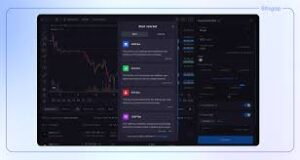Grasp the Middle Band in Bollinger Bands

Bollinger Bands are a powerful tool in a trader’s arsenal, and the middle band is the key to unlocking their full potential. By understanding the middle band, traders can better predict market trends, identify support and resistance levels, and make more informed decisions. Dive into the world of Bollinger Bands and discover how this simple moving average can transform your trading strategy. Go https://immediate-edge.software/ to learn more and access premium investment education from top firms.
Decoding the Middle Band: Core Concepts

The middle band in Bollinger Bands is a key tool for traders. It serves as the foundation for the upper and lower bands. Essentially, this middle band is a simple moving average (SMA) of the asset’s price. Traders often use a 20-day SMA, but the period can be adjusted based on trading strategy and market conditions.
Understanding the middle band starts with grasping the SMA concept. This average is calculated by adding the closing prices of an asset over a specific period and then dividing by that number of days. For example, in a 20-day SMA, you’d add up the closing prices of the last 20 days and divide by 20. This average helps smooth out price data, offering a clearer view of trends over time.
The middle band acts as a trend indicator. When prices consistently hover above the middle band, it suggests an upward trend. Conversely, prices below the middle band signal a downward trend. This makes the middle band a valuable reference point for traders looking to gauge market direction.
Moreover, the middle band plays a crucial role in identifying support and resistance levels. When prices approach the middle band, they often encounter a level of resistance or support, depending on the trend direction. This interaction can provide signals for potential buying or selling opportunities.
In summary, the middle band is more than just a moving average. It’s a vital part of the Bollinger Bands, helping traders identify trends, and support, and resistance levels, and make informed trading decisions.
The Middle Band’s Function in Market Analysis
The middle band in Bollinger Bands is not just a technical tool; it’s a cornerstone for market analysis. Its primary function is to smooth out price data, revealing the underlying trend by filtering out short-term fluctuations.
In market analysis, the middle band serves as a trend indicator. When prices stay above the middle band for an extended period, it indicates an upward trend. Conversely, prices below the middle band suggest a downward trend. This straightforward interpretation helps traders make informed decisions about market direction.
The middle band also assists in assessing market volatility. When the bands widen, it signals increased volatility, whereas narrowing bands indicate reduced volatility. The middle band, being the moving average, provides a stable reference point amid these changes, helping traders adjust their strategies accordingly.
Another critical function of the middle band is identifying potential support and resistance levels. When the price approaches the middle band from above, it often acts as a support level, potentially halting a downward move. When the price approaches from below, the middle band can serve as a resistance level, impeding an upward move. This behavior can be instrumental in planning entry and exit points for trades.
Moreover, the middle band can be used in conjunction with other technical indicators to enhance analysis. For instance, combining it with the Relative Strength Index (RSI) can provide more comprehensive insights into market conditions.
Strategic Applications of the Middle Band
Using the middle band strategically can enhance trading outcomes. One common application is identifying entry and exit points. Traders often buy when the price touches or moves above the middle band during an upward trend. Conversely, selling when the price dips below the middle band in a downward trend can help lock in profits or minimize losses.
Another strategy involves using the middle band to confirm trends. For instance, if the price is consistently above the middle band and the bands are widening, it indicates a strong upward trend. Traders can use this confirmation to hold onto their positions longer. On the other hand, if the price stays below the middle band and the bands widen, it confirms a downward trend, signaling traders to stay short or exit long positions.
The middle band can also be integrated with other technical indicators. For example, combining the middle band with the Moving Average Convergence Divergence (MACD) can provide a more nuanced view of the market. The MACD can signal momentum shifts, while the middle band confirms the trend, helping traders make more informed decisions.
Moreover, customizing the SMA period of the middle band can tailor it to different market conditions. Shortening the period can make the middle band more responsive to recent price changes, suitable for volatile markets. Lengthening the period can smooth out the band, providing a clearer view of long-term trends.
Conclusion
Mastering the middle band in Bollinger Bands offers a significant edge in trading. It helps in trend identification, market analysis, and strategic decision-making. By integrating this tool into your trading approach, you can enhance your market insights and improve your trading outcomes. Stay informed, practice regularly, and consult with financial experts to maximize your success.







